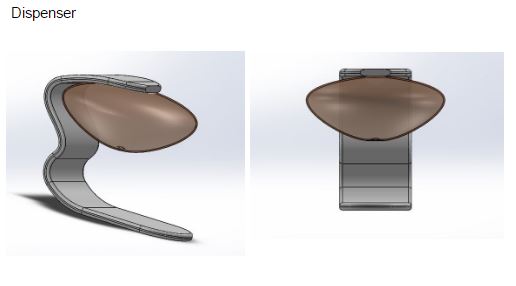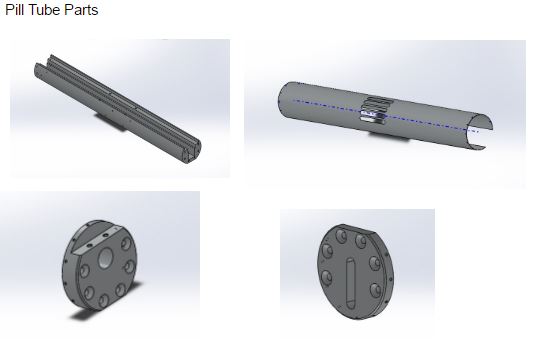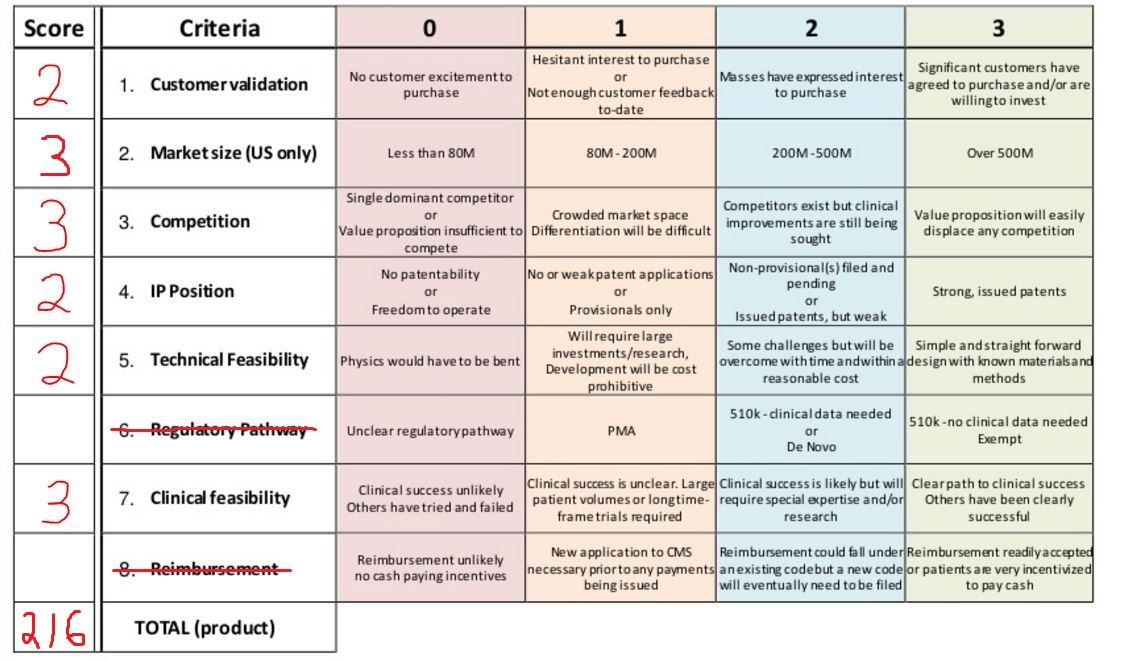BME100 f2016:Group9 W1030AM L2
| Home People Lab Write-Up 1 | Lab Write-Up 2 | Lab Write-Up 3 Lab Write-Up 4 | Lab Write-Up 5 | Lab Write-Up 6 Course Logistics For Instructors Photos Wiki Editing Help | |||||||
OUR TEAM
LAB 2 Prototype DesignDevice Image and DescriptionDescription of Prototype The pill dispenser consists of a large compartment that holds the tubes of various pills and has a hole in the bottom where pills are dispensed, a curved stand that holds the compartment in the air, a small screen and fingerprint reader on the base of the stand. Our picture is unable to show the computer components in the base of the stand and also the opening in the large compartment where pill tubes are inserted and ejected. It has an alarm and light to indicate when it is time to take the next dose and components that allow it to notify the patient of the dose, doctor if there is any abuse or caretaker if a needed pill has not been taken. The pill tubes are the means of holding a dosage of pills given from a doctor and pharmacy. It is tamper proof but this drawing is a bit more bulky than the actual design will be and the slots on the side of the tube would be removed. This is inserted into the compartment of the dispenser where it can be opened and pills dispensed out in the intervals of time prescribed by the doctor. A barcode on the tube can be read by the dispenser to know what type of pill and how often the doctor has prescribed the patient to take the pill. These two items work together to assure that prescription medication will not be abused or forgotten. If the pill tubes are not inserted in the machine or the tubes are tampered with the dispenser will notify the doctor, caretaker, etc. If the dispenser itself is tampered with the pills will still be in the individual tubes that cannot be tampered with and the doctor will be notified. Patients will not be able to overdose or take pills too often. Also those who tend to forget their medication will have a dispenser that will notify them of each dose. The family and caretaker can also know so they can call or personally stop to ensure that everything is fine.
Technical and Clinical FeasibilityTechnical Feasibility A) In general, the technologies needed to design our product already exist. The principle is relatively simple; we want a machine that notifies the patient when they are ready for their next dose and can dispense the medication. Machines like this are already on the market. One of the critical differences between our machine and others is that it is enabled to communicate with the doctor whether or not the patient has been taking their medication. It would do this by uploading data over the patient's home WiFi network to a server every time the patient takes their medication. Then, the doctor can access this server by going to a secure website on their computer. While innovative, the technology for this is hardly new. Another major difference is that our machine is tamper proof. When drugs that are easy to abuse, like morphine or adderall, are being used in the machine, tamper proof containers would be used to store the drugs. These containers would be filled by the pharmacy and would be difficult to break into. In addition, if a patient did force his or her way into the container, the doctor would know because the dispenser would report that it was not loaded at the next time it tries to dispense pills to the patient. Although these containers do not exist yet, the technology to build them (durable materials, locks) already exist. One issue that exist are that the pharmacies would have to get on board and have a way to put pills into our secure containers when patients bring them. Additionally, it is possible that a determined patient would find a way to tamper with the containers. Therefore, I would give our product a 2 on technical feasibility. B) Designing the prototype on SolidWorks is the biggest challenge. Also, finding a way to make all the hardware fit into a compact model is a priority, but it will not be easy. C) Things that could go wrong with our dispenser include the dispensing of the wrong amount of pills, sending false alarms to the doctor about the patient abusing the medicine, and hardware malfunctions.
Clinical Feasibility Devices similar to this one have been used before and have had high success rates. Since ours is similar , we can expect a high level of clinical success. Our device is not invasive in any way, and it puts no one in danger making it a Class 1 device, thus there is no need for clinical trials. It is easy to use by anyone, and the pills are stored in different slots of the dispenser making the refilling process quite systematic. Therefore, I would give it a 3 on clinical feasibility.
Market AnalysisValue Creation The value of our product is higher than others because of a number of factors. First of all, no other device allows the doctor to check in on the patient. Additionally, very few other products are tamper proof. Our product would allow people to take their medication at the prescribed time, preventing them from abusing the drug and potentially overdosing. This is incredibly important, as over 20 thousand people die each year from prescription drug overdoses. Additionally, a tamper proof design would prevent people from selling their prescription drugs. Prescription drugs abuse is on the rise, especially with narcotic painkillers and drugs like adderall, so this is an important innovation.
Plastics: Nylon 6, $4.50 per kilogram https://www.alibaba.com/product-detail/Nylon-Rods-nylon-extruded-Nylon-6_60464499150.html?spm=a2700.7724857.0.0.McHPDP&s=p Screen: $0.1 https://www.alibaba.com/product-detail/1-inch-lcd-screen-UNTFT40096_60401992791.html?spm=a2700.7724857.0.0.zDHwhM Speaker: $1.1-174 Computer: Raspberry Pi model 3, $38 http://www.newegg.com/Product/Product.aspx?Item=9SIA5YB4AM9292&cm_re=rasberry_pi_3-_-13-300-007-_-Product Wire: $0.25/foot Light: $14 for 5, $2.8 per unit http://www.lightmalls.com/cree-xml-t6-1000-lumen-led-emitter-5pcs?gclid=Cj0KEQjw6uO-BRDbzujwtuzAzfkBEiQAAnhJ0LugZUxO8Lwgcgpzkj8YmDZu6CKc4GiCLURlH_Z1nTUaAh4u8P8HAQ Metal: aluminum, ~4.00/lb http://www.discountsteel.com/items/6061_Aluminum_Flat_Bar.cfm?item_id=133&size_no=2&pieceLength=full&len_ft=0&len_in=0&len_fraction=0&itemComments=&qty=1 Total cost for materials: around $56 Labor: $7.25/hr assembly chain employee $15/hr for manager or $2.14 per unit Total cost for labor: $9.39 Total cost per unit: ~$65.39
The starting price of automatic pill dispensers is at about 400 USD and can go up to about 950 USD. The cheaper models are quite primitive and are very prone to tampering and cannot communicate with the doctor. The most advanced model on the market today is either the MEDSmart Plus Monitored automatic dispenser which is not tamper proof, but provides messages by SMS or email to the respective caregiver or the E-Pill MD3 which is tamper proof, but does not communicate with the doctor or caregiver. We want to sell our product at 650 USD. We feel that this is a generous price for a device of this caliber. We wanted to make this device more affordable than the other two alternatives, but at the same time we feel that we need to be making a small profit Market Size Chronic pain is defined quite vaguely as a pain that lasts for more than 3 months or past the time of normal tissue healing in the individual. The estimated amount of people experiencing chronic pain in the United States is varied, but it is clear that the number is substantial. Researchers estimate that 9.6–11.5 million adults, or approximately 3%–4% of the adult U.S. population, were prescribed long-term opioid therapy in 2005. The Drug Abuse Warning Network estimated that >420,000 emergency department visits were related to the misuse or abuse of narcotic pain relievers in 2011. There are 43.1 million senior Citizens (age 65 and older) now and by 2040 that number will rise to 79.7 million. About 92% of senior citizens have one chronic condition, and 77% have at least two. Patients Annually: About 12 million patients a year are prescribed with opioid therapy medication under the age of 65. About 39 million senior citizens have one chronic health condition that has medication prescribed by a physician. A total of 51 million patients a year taking prescribed medication for a chronic health condition. Some annual medication related costs include: Physician visits cost $13.8 billion Emergency department visits cost $5.8 billion $24 billion is spent on medication-related problems in other settings Using this device would hopefully cut down on these costs. The Market Size based on sales price and amount of patients a year is a 33.1 Billion USD market
Fundability DiscussionBased on the score of 216 of our model, we strongly feel that our product should be funded. Although the size of the Market might be slightly exaggerated because not everyone with a chronic health condition will end up buying an automatic medicine dispenser, we feel that there will still be a substantial amount of people who do. We feel that products similar to ours exists, but we will be providing a slick new design with added features such as improved communication with caregivers and doctors, and a serious improvement on tamper proofing.
Bibliographyhttp://www.cdc.gov/mmwr/volumes/65/rr/rr6501e1.htm Boudreau D, Von Korff M, Rutter CM, et al. Trends in long-term opioid therapy for chronic non-cancer pain. Pharmacoepidemiol Drug Saf 2009;18:1166–75 https://www.ascp.com/articles/about-ascp/ascp-fact-sheet Bates D. W., Spell N., Cullen D. J. et al. The costs of adverse drug events in hospitalized patients. JAMA 1997;277:307–11. http://www.drugwarfacts.org/cms/Causes_of_Death#sthash.wN5gA1eO.dpbs Pill Dispenser- Modification of an original SolidWorks design by Zach Robinson called Umbra Drop. Downloaded file from GrabCad. URL: https://grabcad.com/library/umbra-drop-3 Pill Tube - Modification of a original SolidWorks design by Daniel Pereira Frenster call Assembly Crosshead Container. Downloaded file from GrabCad. URL: https://grabcad.com/library/assembly-crosshead-container-1 |
|||||||



